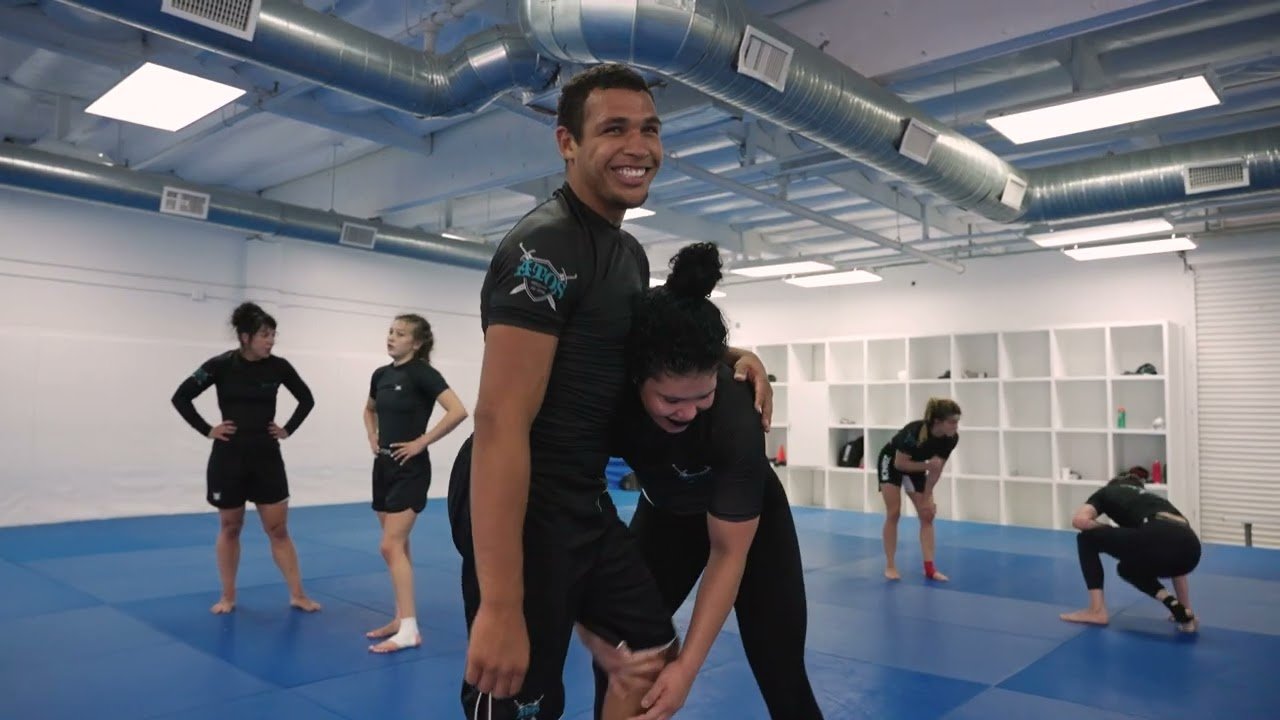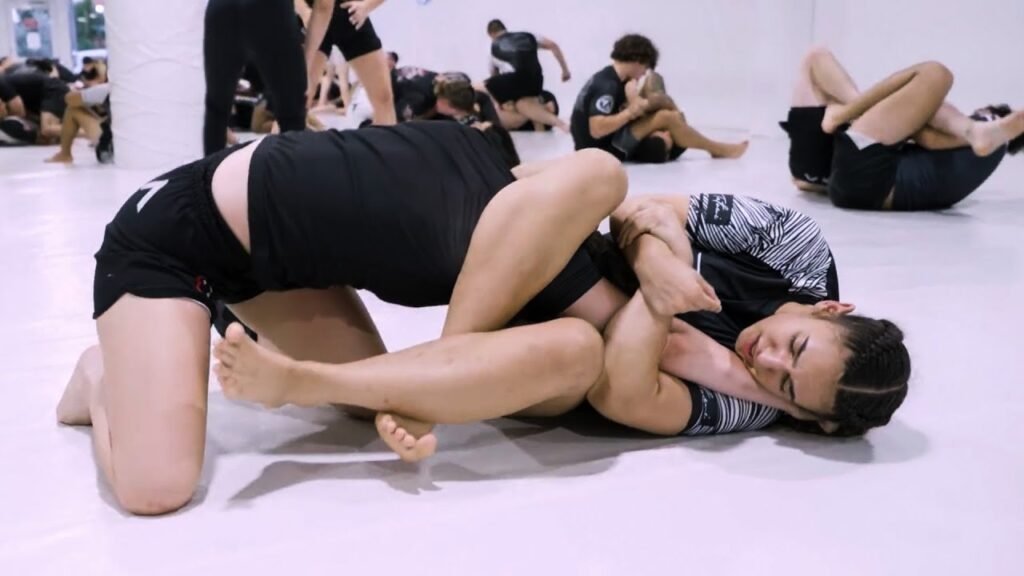
Positional Sparring: Tye Ruotolo & Rafaela Guedes
In this video by FloGrappling, titled “Positional Sparring: Tye Ruotolo & Rafaela Guedes,” viewers are treated to an intense jiu jitsu training session. The video kicks off with Papa, a participant in the training, showing up smelling like plumeria flowers, which adds a pleasant twist to the session. As the video progresses, Tye Ruotolo and Rafaela Guedes engage in positional sparring, showcasing their skills and techniques. The energy is palpable as they execute moves like body locks and switches, keeping the audience on the edge of their seats. Whether you’re a seasoned jiu jitsu enthusiast or new to the sport, this video is sure to captivate and inspire. Don’t forget to like, comment, and subscribe to FloGrappling’s channel for more thrilling jiu jitsu content!

Positional Sparring: Tye Ruotolo & Rafaela Guedes
Positional sparring is a training method widely used in Brazilian Jiu-Jitsu (BJJ) to develop specific skills and improve overall performance. It involves isolating certain positions or scenarios and focusing on specific aspects of the game. In this article, we will explore the backgrounds of two highly skilled BJJ practitioners, Tye Ruotolo and Rafaela Guedes, and examine the benefits, rules, and different positions in positional sparring. We will also delve into their unique approaches to positional sparring and provide training tips for effective practice. So let’s dive in!
Introduction to Positional Sparring
Positional sparring is a drill-based training technique employed by BJJ practitioners of all levels. It allows individuals to focus on specific positions, transitions, and techniques, providing valuable repetitions and opportunities for improvement. Unlike live or rolling sparring sessions, positional sparring allows practitioners to isolate and target specific areas of their game.
Positional sparring is especially beneficial in developing a deep understanding and proficiency in various BJJ positions, such as the guard, mount, and back control. By honing their skills in these positions, practitioners can enhance their overall grappling capabilities and become more effective on the mats.
Tye Ruotolo’s Background
Tye Ruotolo is a rising star in the world of BJJ. Alongside his twin brother Kade, Tye has made waves in the competitive scene, showcasing a dynamic and technical style of grappling. Hailing from California, Tye began his BJJ journey at a young age and quickly rose through the ranks. With numerous titles under his belt, including World Championships and Pan American Championships, Tye is known for his aggressive style and relentless pursuit of victory.
Rafaela Guedes’ Background
Rafaela Guedes is a highly accomplished BJJ black belt and an influential figure in women’s jiu-jitsu. Originally from Brazil, Rafaela has competed at the highest levels, earning accolades such as the World Championships and the prestigious Abu Dhabi World Pro. Known for her technical prowess and strategic mindset, Rafaela has mastered the art of control and submission, making her a formidable opponent in any competition.
Benefits of Positional Sparring
Positional sparring offers several key benefits that can significantly contribute to an individual’s development in BJJ. Let’s explore some of these advantages in detail.
Improves Specific Techniques
One of the primary benefits of positional sparring is the opportunity it provides to focus on specific techniques. By isolating particular positions, practitioners can fine-tune their understanding and execution of specific moves. For example, by engaging in guard-specific positional sparring, a practitioner can sharpen their sweeping, submissions, and guard passing techniques, resulting in a more well-rounded game.
Enhances Competition Readiness
Positional sparring is an excellent tool to prepare for competitions. By simulating specific scenarios that one might encounter during a match, practitioners can develop a heightened sense of awareness and adaptability. Additionally, positional sparring allows individuals to simulate the intensity and pressure of competition, helping them become more composed and focused when facing challenging opponents.
Builds Mental Toughness
Positional sparring can be mentally demanding, requiring practitioners to remain focused and resilient even in unfavorable positions. By repeatedly facing challenging situations and working through them, individuals develop mental toughness and learn to stay calm under pressure. This mental fortitude translates not only to their training but also to other areas of life, fostering discipline and resilience.
Rules and Guidelines in Positional Sparring
While positional sparring may seem straightforward, adhering to certain rules and guidelines can ensure a safe and productive training environment. Let’s explore some essential aspects of positional sparring.
Clear Objectives
Before engaging in positional sparring, it is crucial to establish clear objectives. Both training partners should understand the specific position or scenario they will be working on. This clarity allows practitioners to focus on improving specific aspects of their game, rather than aimlessly rolling without a purpose.
Communicating Intentions and Limitations
Communication is key in positional sparring. It is important for both practitioners to communicate their intentions and limitations beforehand. This can include discussing the level of intensity, preferred focus areas, and any injuries or physical limitations. By openly communicating, training partners can tailor their sparring session to suit each other’s needs and goals.
Safety Precautions
Safety should always be a top priority in positional sparring. While it is an opportunity to refine techniques and test one’s skills, practitioners must exercise caution and respect for their training partners. This includes using controlled force, avoiding reckless movements, and tapping out when caught in submissions. Additionally, regular communication during positional sparring can help prevent any potential injuries or accidents.
Different Positions in Positional Sparring
Positional sparring encompasses a range of different positions, each with its own unique challenges and opportunities. Let’s take a closer look at some of the most common positions in positional sparring.
Guard Positions
Guard positions, such as the closed guard, open guard, and half guard, play a crucial role in BJJ. Engaging in positional sparring from various guard positions allows practitioners to develop a solid offense and defense strategy. Practitioners can work on techniques such as sweeps, submissions, and guard recovery, enabling them to effectively control and neutralize their opponents.
Mount Positions
The mount is a dominant position where one practitioner is seated on top of their opponent’s chest. Positional sparring from different mount variations, such as the high mount or low mount, allows practitioners to master control and apply effective submission holds. It also enhances their ability to restrict the opponent’s movements and minimize escape options.
Back Control Positions
The back control position provides a significant advantage in BJJ, as it offers numerous opportunities for submissions and control. Positional sparring from the back control allows practitioners to sharpen their attacking and defensive skills. By training from this position, individuals learn to maintain control, establish hooks, and secure a strong rear-naked choke, making them formidable opponents in any match.
Tye Ruotolo’s Approach to Positional Sparring
Tye Ruotolo has developed a unique approach to positional sparring, focusing on specific aspects that elevate his game. Let’s dive into Tye’s approach and explore the key elements that contribute to his success.
Focus on Transitions
Tye excels at seamlessly transitioning between positions. During positional sparring, he places a strong emphasis on developing fluid and efficient transitions. By honing his ability to smoothly move from one position to another, Tye maintains control and initiates attacks, providing him with a significant advantage over his opponents.
Exploiting Weaknesses
Tye possesses a keen eye for identifying and capitalizing on his opponent’s weaknesses. In positional sparring, he actively seeks opportunities to exploit vulnerabilities and launch attacks. By relentlessly pressuring his opponents and exposing their weaknesses, Tye maintains a dominant position and creates openings for submissions and transitions.
Building a Systematic Game Plan
Another hallmark of Tye Ruotolo’s approach to positional sparring is his systematic game plan. He develops a structured approach to each position, carefully analyzing the strengths and weaknesses associated with it. By implementing a well-thought-out game plan, Tye maximizes his efficiency and effectiveness in positional sparring, ensuring he gets the most out of each training session.
Rafaela Guedes’ Approach to Positional Sparring
Rafaela Guedes, known for her technical brilliance, brings her unique approach to positional sparring. Let’s explore the key elements that define Rafaela’s method and contribute to her success on the mats.
Emphasis on Grips and Control
Rafaela understands the importance of establishing and maintaining strong grips and control in positional sparring. She uses this approach to limit her opponent’s options and dictate the pace of the match. By prioritizing grips and control, Rafaela gains a tactical advantage, setting up submissions and openings for dominant positions.
Implementing Gi Techniques in No-Gi
While Rafaela has achieved success in both gi and no-gi competitions, she recognizes the value of incorporating gi techniques into her no-gi positional sparring. By adapting gi techniques to the no-gi environment, she introduces new and unexpected elements that catch her opponents off guard. This adaptability enhances her overall game and makes her a well-rounded and versatile grappler.
Using Positional Dominance to Set Up Submissions
Rafaela excels at using positional dominance as a means to set up submissions. By strategically maneuvering herself into advantageous positions, such as the mount or back control, she creates opportunities to attack. Her ability to seamlessly transition from controlling positions to submission attempts makes her a formidable opponent in positional sparring and competitions.
Training Tips for Effective Positional Sparring
To make the most of your positional sparring sessions, it is essential to train with intention and focus. Here are some tips to enhance your training experience:
Start from Disadvantageous Positions
To challenge yourself and develop resilience, start positional sparring from disadvantageous positions. This could mean starting in an opponent’s dominant position or purposely giving up a position. By confronting and learning to work through these difficult situations, you will become more adept at problem-solving and developing effective escapes.
Set Time Limits for Each Position
To ensure efficiency and equal opportunities for both training partners, set time limits for each position during positional sparring. This prevents one person from dominating the session or stalling in a specific position. By adhering to time limits, you enhance the intensity and focus during each round, maximizing the benefits of positional sparring.
Analyze and Learn from Sparring Sessions
After each positional sparring session, take the time to analyze your performance, identify areas for improvement, and learn from your mistakes. This reflective practice allows you to refine your techniques, understand your tendencies, and develop new strategies. By embracing a growth mindset and consistently learning from your sparring sessions, you will accelerate your progress on the mats.
Common Mistakes in Positional Sparring
While positional sparring can be immensely valuable, certain common mistakes can hinder progress. Let’s explore some of these mistakes and how to avoid them.
Lack of Focus on Technique
It is crucial to maintain a focus on technique during positional sparring, rather than solely relying on strength or athleticism. By neglecting proper technique execution, individuals miss out on potential learning opportunities and limit their growth. Focus on technical precision and efficiency to maximize the benefits of positional sparring.
Neglecting Defensive Strategies
Positional sparring is not solely about attacking; it also provides an opportunity to sharpen defensive skills. Neglecting defensive strategies can leave individuals vulnerable and limit their ability to withstand challenging situations. Balancing offense with defense during positional sparring ensures a well-rounded skill set and prepares individuals for a variety of scenarios.
Overlooking Positional Hierarchy
Each position in BJJ carries its own set of advantages and disadvantages. Overlooking the positional hierarchy can hinder growth and limit the development of a well-rounded game. It is essential to understand the strengths and weaknesses associated with different positions and actively work on improving in each of them. By recognizing the significance of positional hierarchy, individuals can build a comprehensive skill set.
Importance of Adaptability in Positional Sparring
Adaptability is a critical skill in BJJ, and it holds particular importance in positional sparring. Let’s explore why being adaptable is crucial and how it can be cultivated.
Adjusting to Opponent’s Style
During positional sparring, individuals often face training partners with different styles and techniques. Being adaptable allows practitioners to adjust their approach and game plan based on their opponent’s strengths and tendencies. By embracing adaptability, individuals can exploit weaknesses, neutralize threats, and effectively control the match.
Developing Multiple Strategies
Adaptability enables individuals to develop multiple strategies in positional sparring. By expanding their repertoire of techniques and approaches, practitioners become more versatile and unpredictable. This enhances their ability to transition between positions, launch attacks, and react to their opponent’s movements. By being adaptable, individuals can adapt to any situation, ensuring their success on the mats.
Building a Versatile Skill Set
Implementing adaptability in positional sparring contributes to the development of a versatile skill set. By exposing oneself to various positions, scenarios, and training partners, individuals become well-rounded grapplers. This versatility expands their understanding of BJJ and equips them with the tools needed to excel in any situation.
Conclusion
Positional sparring is a valuable training tool in the world of BJJ, providing practitioners with the opportunity to refine their techniques, enhance competition readiness, and build mental toughness. By establishing clear objectives, communicating effectively, and prioritizing safety, individuals can make the most of their positional sparring sessions. Learning from the approaches of skilled practitioners like Tye Ruotolo and Rafaela Guedes, and implementing training tips can elevate one’s positional sparring experience and overall performance on the mats. So, embrace positional sparring, be adaptable, and continue your journey towards success in BJJ.

